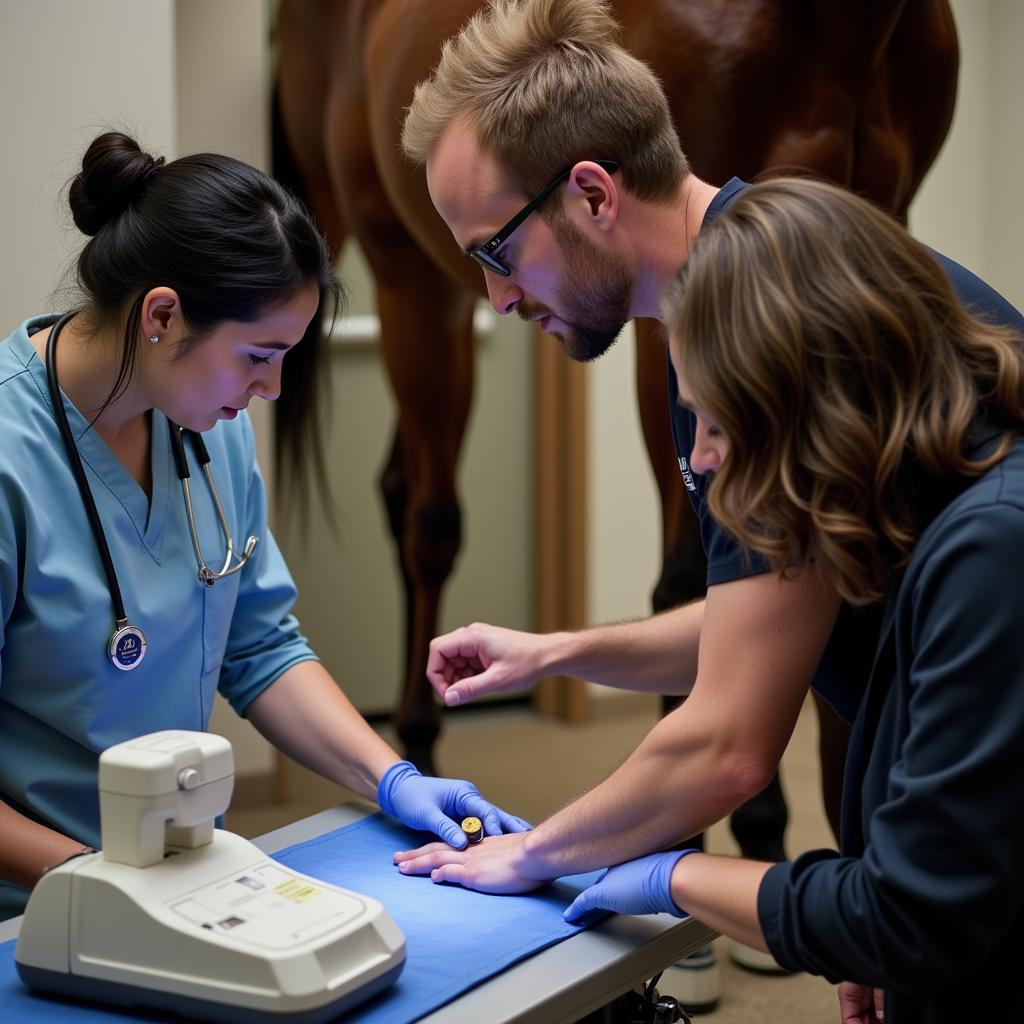The Horse Tibia, a crucial bone in the equine hind limb, plays a vital role in their movement and overall well-being. Understanding its anatomy, common injuries, and proper care is essential for any horse owner or enthusiast. This comprehensive guide will delve into the intricacies of the horse tibia, equipping you with the knowledge to ensure your equine companion’s health and soundness.
What is the Tibia in a Horse?
The tibia in a horse is a long bone located in the lower hind leg, situated between the stifle joint (similar to the human knee) and the hock joint. It is the larger of the two bones in the lower leg, with the smaller fibula running parallel to it. The tibia primarily functions as a weight-bearing bone, transmitting the force generated by the powerful hindquarters to the ground.
Anatomy of the Horse Tibia
The horse tibia exhibits a unique structure perfectly adapted for its function. Let’s break down its key features:
- Proximal End: The upper end of the tibia connects to the femur (thigh bone) at the stifle joint. This articulation forms a hinge-like structure, allowing for forward and backward movement of the leg.
- Shaft: The long, slender body of the tibia is known as the shaft. Its strength and integrity are vital for withstanding the stresses of locomotion.
- Distal End: The lower end of the tibia articulates with the talus bone in the hock joint, forming another crucial joint for hind limb movement.
Common Horse Tibia Injuries
Due to its weight-bearing role and involvement in complex movements, the horse tibia is susceptible to various injuries, including:
- Fractures: Tibial fractures can occur due to traumatic incidents, such as kicks from other horses or falls.
- Splints: These bony growths typically occur on the inner aspect of the tibial shaft and are often associated with inflammation of the interosseous ligament, which connects the tibia and fibula.
- Osteoarthritis: This degenerative joint disease can affect the stifle or hock joint, both of which involve the tibia, leading to pain, stiffness, and lameness.
 Horse Tibia Fracture
Horse Tibia Fracture
Diagnosing Tibia Problems in Horses
Recognizing the signs of tibia problems is crucial for early intervention. If you observe any of the following symptoms in your horse, consult your veterinarian immediately:
- Lameness: A noticeable limp or reluctance to bear weight on the affected leg.
- Swelling: Inflammation around the tibia, particularly near the stifle or hock joint.
- Heat: Increased temperature in the affected area, indicating inflammation.
- Pain: Sensitivity to touch or pressure on the tibia.
Veterinarians employ various diagnostic tools to accurately assess tibia-related issues, including:
- Physical Examination: A thorough evaluation of the horse’s gait, posture, and palpation of the leg to identify areas of pain, swelling, or instability.
- Radiographs (X-rays): Provide detailed images of the bone structure, revealing fractures, bone changes, or joint abnormalities.
- Ultrasound: Uses sound waves to create images of soft tissues, aiding in the diagnosis of ligament or tendon injuries associated with the tibia.
 Horse Leg Ultrasound
Horse Leg Ultrasound
Treatment and Management of Horse Tibia Issues
Treatment approaches for tibia problems vary depending on the specific injury, its severity, and individual horse factors. Common treatment modalities include:
- Rest and Immobilization: Restricting movement through stall rest or controlled exercise is often the initial step in managing tibia injuries.
- Medications: Nonsteroidal anti-inflammatory drugs (NSAIDs) help reduce pain and inflammation, while other medications may be prescribed to manage specific conditions.
- Surgery: In cases of severe fractures or joint instability, surgical intervention may be necessary to stabilize the bone, repair ligaments, or address joint damage.
- Rehabilitation Therapy: Following surgery or a period of immobilization, a tailored rehabilitation program incorporating controlled exercise, physical therapy, and other modalities helps restore strength, flexibility, and range of motion.
Preventing Tibia Injuries in Horses
While not all injuries are preventable, implementing certain management practices can significantly reduce the risk of tibia problems in your equine companion:
- Provide Safe Fencing and Pastures: Ensure fences are sturdy and well-maintained to prevent horses from getting legs caught or entangled.
- Maintain Proper Footing: Adequate footing in stalls, paddocks, and riding arenas is crucial. Slippery or uneven surfaces increase the risk of slips, falls, and subsequent injuries.
- Warm Up and Cool Down Properly: Always allow your horse ample time to warm up before strenuous activity and cool down afterward. This helps prevent muscle strains and injuries.
- Regular Veterinary Check-ups: Schedule routine veterinary examinations to detect any potential issues early on and address them before they escalate.
Conclusion
The horse tibia, a cornerstone of their hind limb structure, plays a pivotal role in their movement and overall well-being. Understanding its anatomy, common injuries, and proper care is paramount for every horse owner. By recognizing the signs of tibia problems, seeking prompt veterinary attention, and implementing preventative measures, you can help ensure your equine companion enjoys a long, healthy, and sound life.
Remember: This information should not be considered a substitute for professional veterinary advice. If you have any concerns about your horse’s health, always consult with your veterinarian for a proper diagnosis and treatment plan.
For more information on horse anatomy and common leg issues, you can refer to our articles on where is stifle on horse and hock on a horse.
Need assistance with your horse’s health or well-being? Contact Justus Horses USA today!
Phone: 0772127271
Email: [email protected]
Address: QGM2+WX2, Vị Trung, Vị Thuỷ, Hậu Giang, Vietnam
Our dedicated team of equine experts is available 24/7 to provide you with the support you need.